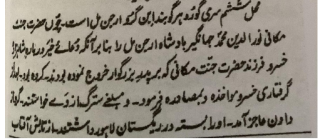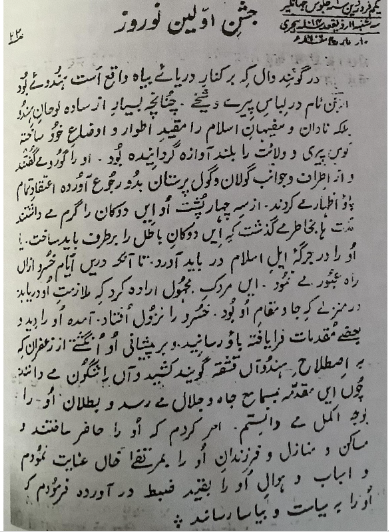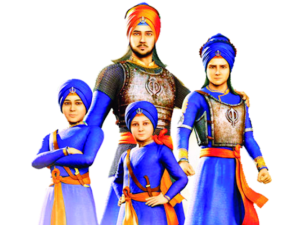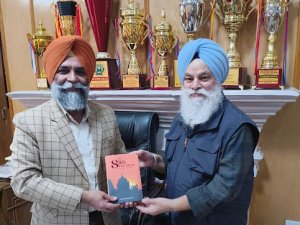Guru Arjan Dev Ji, the fifth Sikh Guru, was born on April 15, 1563, in the village of Goindwal, present-day Tarn Taran district in Punjab, India. He was the youngest son of Guru Ram Das Ji, the fourth Sikh Guru, and Mata Bhani Ji. From an early age, Guru Arjan Dev Ji showed spiritual inclination and devotion. He received his early education and training under the guidance of his father, Guru Ram Das Ji. He also received teachings from prominent Sikh scholars and religious figures of the time. Guru Arjan Dev Ji was married to Mata Ganga Ji, and they had two sons: Prithi Chand and Mahadev (also known as Guru Hargobind Sahib, who later became the sixth Sikh Guru). He emphasized the importance of family life and the responsibilities of being a householder while maintaining devotion to God.
In addition to his spiritual pursuits, Guru Arjan Dev Ji actively participated in the construction and development of the Sikh community. He played a crucial role in the expansion of Goindwal as a religious center and established the township of Tarn Taran, including the excavation of the sacred Tarn Taran Sahib tank.Guru Arjan Dev Ji's compassionate nature and commitment to serving humanity were evident from his efforts to promote equality and social justice. He emphasized the importance of honest labor, sharing with the needy, and living a righteous life.
Throughout his early life, Guru Arjan Dev Ji demonstrated wisdom, humility, and a deep understanding of spirituality. These qualities would continue to shape his leadership and influence as the fifth Sikh Guru, leaving a lasting impact on Sikhism.
When Guru Arjan Sahib was requested by Bhai Sangaru and Bhai Jaita Ji to take up the sword, Guru Sahib said, "We (Guru) take the form of Har Gobind and take up the armor, the time is to use Kaliyuga. " By studying weapons, you have to draw the Miri of Mir and by loving words, you have to take the Piri of Pir. You stay in the presence of the sixth king. (Sikhan de Bhagat Mala, 158).
Before leaving Lahore, Guru Arjan Sahib gave his last command to his son (Guru) Har Gobind, "Sit on your throne as a steward and keep an army according to your ability." (The Sikhs and their scriptures, Loehlin PP. 31-32, A short history of the Sikhs-Teja Singh, Ganda Singh, Vol. 1, p. 30).
Pursuant to the order of Guru Arjan Sahib, Guru Hari Gobind Singh started the proclamation of the Sikh army. Guru Arjan Sahib also addressed the leading Sikhs with highly eloquent sermons.
Guru Arjan Dev Ji is credited with compiling the Guru Granth Sahib, the central religious scripture of Sikhism. The compilation process involved collecting the writings of the previous Sikh Gurus, as well as compositions of various saints and devotees from different spiritual traditions. Guru Arjan Dev Ji collected the hymns and compositions of the previous Sikh Gurus, including Guru Nanak Dev Ji, Guru Angad Dev Ji, Guru Amar Das Ji, and Guru Ram Das Ji.
These writings were already revered within the Sikh community, and Guru Arjan Dev Ji recognized their spiritual scripture. Guru Arjan Dev Ji carefully selected the writings to be included in the Guru Granth Sahib. He chose hymns that exemplified the teachings of Sikhism, emphasizing devotion to the One Supreme Being, ethical conduct, and the path to spiritual liberation. The compositions were in various languages and dialects, including Punjabi, Hindi, and Persian. In addition to the Gurus' writings, Guru Arjan Dev Ji also included compositions from other spiritual figures, both Hindu and Muslim. These included saints and bhaktas from diverse backgrounds, such as Kabir, Namdev, Ravidas, and Sheikh Farid, among others. The purpose was to emphasize the universality of spiritual truth and to promote unity among different communities. For this service, Bhai Gurdas ji made a great contribution through his pen. The most verses in Sri Guru Granth Sahib is by Guru Arjan Dev Ji. The main works of Guru Sahib Ji include Sukhmani Sahib , Barhamhan, Bawan Akhri etc.
Guru Arjan Dev Ji personally supervised the compilation process. He organized the selected hymns and compositions in a systematic manner, categorizing them according to their musical measures or ragas. The compilation process took several years to complete. The compiled scripture was initially known as the Adi Granth. Guru Arjan Dev Ji installed it in the newly constructed Harmandir Sahib (Golden Temple) in Amritsar, Punjab. The Adi Granth served as the central religious text and source of spiritual guidance for the Sikh community.
Guru Arjan Dev Ji, after carefully reviewing and scrutinizing the compiled scripture, declared it to be the final and eternal Guru of the Sikhs. He appointed Baba Buddha Ji, a respected Sikh elder, to be the custodian of the Adi Granth. The compilation of the Guru Granth Sahib by Guru Arjan Dev Ji was a significant milestone in Sikh history. It solidified the central teachings of Sikhism and provided a unifying scripture that continues to guide and inspire Sikhs around the world. Guru Arjan Dev Ji's death was a result of the persecution he faced under the Mughal Emperor Jahangir. There were various factors that led to his torture and execution.
Guru Arjan Dev Ji's increasing influence and the rapid growth of Sikhism raised concerns among some Mughal officials, including Chandu Shah, a prominent Hindu merchant. Chandu Shah held a personal grudge against Guru Arjan Dev Ji due to a perceived insult to his daughter during marriage negotiations with Guru's family. Chandu Shah conspired with Jahangir's court to falsely accuse Guru Arjan Dev Ji of supporting the rebellion of Jahangir's son, Prince Khusrau. The motive behind these accusations was to tarnish the Guru's reputation and undermine his growing influence. Guru Arjan Dev Ji was arrested in May 1606 and brought to Lahore, where he was subjected to torture. Jahangir's orders allowed for severe punishment, including physical torture, in an attempt to force the Guru to convert to Islam and relinquish his Sikh beliefs. Guru Arjan Dev Ji remained steadfast in his faith and refused to renounce Sikhism or compromise his principles. He endured extreme torture, including being made to sit on a scorching hot iron plate while hot sand was poured over his body. Despite the agony, Guru Arjan Dev Ji maintained his composure and remained in meditation, providing inspiration to his followers.
According to Dabistan-i-Mujahib, "When Nurdin Muhammad Jahangir, the ruler of Janat, arrested Shahzada Khusro, he ordered the arrest of Guru Arjan Dev ji, because he prayed in favor of Shahzada Khusro, who had rebelled against his father and demanded a huge amount of fine, which Guru Sahib could not pay. Therefore, he was tied and kept in the desert of Lahore, where he died with the heat of the sun, excessive heat and the hardships given by the extortionists. This happened in Hijri 1015. (Ganda Singh, Phulwari Lahore, 1931, p.2)
A page from Dabistan-i-Mujahib
In fact, paying the fine seems absurd. Dabistan the writer seems to have heard this from someone and wrote it down. The main reason for these things was that some Brahmins and Mullahs were already not happy with Guru Sahib's brilliance. They used to fill his ears against the Guru Sahib to Emperor Jahangir . Birbal was one of those gossips. If there was any truth in the imposition of fines, it would have been mentioned in the king's own writings. Jahangir writes in his autobiography, "In Goindwal, which is on the banks of the river Beas, there was a Hindu named Arjan in the garb of old men, who converted many naive Hindus but also stupid and ignorant Muslims. He was also made a disciple of his code of conduct and was called his guardian and peer. They called him 'Guru'. Fraudulent and deceitful people from all sides come to him and do their best on him. They used to show devotion. He had been running this shop for three or four centuries. For a long time, the thought was rising in my heart that this shop of lies should be closed, or it should be brought into the Muslim fold. I ordered that he should be produced, and I ordered his household and children to be handed over to Murtaza Khan and, confiscating his property, ordered that he should be punished under 'Siyast and Yasa'.”
A Page from Tuzuki Jahangiri
Many tortures and sufferings were given to Guru Sahib. It is mentioned that Guru Sahib was placed on a tatti tawi, hot sand was poured over his body and then he was boiled in a pot. According to Dabistan, "Guru Ji was not given anything to eat or drink, was thrown into a hot pot and stoned, causing his head to bleed. He was tortured for three to five days. On 30th May 1606 AD, Guruji's hands and feet were tied with blisters and were thrown into the Ravi River where they disappeared."
Subsequently, Guru Arjan Dev ji was subjected to severe torture and executed in Lahore. On May 30, 1606, Guru Arjan Dev Ji attained martyrdom. He instructed his followers to view his martyrdom as a blessing and to continue following the path of righteousness.
Responsibility for Guru Arjan Dev Ji's torture and execution lies primarily with the Mughal Emperor Jahangir and his officials, including Chandu Shah. Jahangir, as the ruler, had the authority to prevent or stop the persecution, but he did not intervene, allowing the torture and execution to take place. Chandu Shah's personal vendetta played a significant role in instigating the false accusations against the Guru. However, it is important to note that Jahangir, as the ultimate authority, bears the ultimate responsibility for the actions taken against Guru Arjan Dev Ji.
After the martyrdom of Guru Arjan Sahib, on one side there were continuous conspiracies of Hindus, Brahmins, and Mullahs, then on the other side there was the hand of Sheikh Ahmed Farid,a disciple of 'Baki Billa’. His great friend Sheikh Farid (Bukhari Murtaza Khan) was influential in the Mughal court and had built a strong position. During Khusro's rebellion, the accused were punished and during these times, Sheikh Sirhindi along with Sheikh Farid Bukhari plotted against Guru Sahib. Jahangir was only looking for an excuse. The martyrdom of Guru Arjan Sahib brought happiness to Sheikh Ahmad Sarhandi, who expressed it through a letter to his chief disciple Sheikh Farid Bukhari (Murtaza Khan). This is recorded in letter No. 193 “Aktubati-Imami-Rabbani”.
"The martyrdom of the corrupt infidel of Goindwal (Guru Arjan Sahib) is our great achievement and victory. No matter how he was killed, for what reason and with what pretext he was killed. It is an event of great benefit and growth for all Muslims. Before this infidel martyrdom, I also had a dream that Emperor Jahangir had crushed the head of an infidel. There is no doubt that this infidel is the chief of the disbelievers and a great leader of the infidels.”
This is Sheikh Ahmed Sarhandi's philosophy of hatred towards other religions, which is revealed in his letters. Guru Sahib's martyrdom ushered in new chapters of Sikhism for the times to come.
Bhai Gurdas ji also writes that on the night of 29th-30th May Guru Sahib was suffering greatly but remained completely calm and unmoved at the time of martyrdom. These words were on their lips:
ਪ੍ਰਗਟ ਭਈ ਸਗਲੇ ਜੁਗ ਅੰਤਰਿ
ਗੁਰ ਨਾਨਕ ਕੀ ਵਡਿਆਈ ॥४॥११॥
Pargat bha sagle jug antar
gur Nanak kī vadi-ā-ī. ||4||11||
(The glorious greatness of Guru Nanak is manifest throughout all the ages.)
Bansawali Nama Dasan Patshahian Ka Author also testifies this.
In this way, the glorification of the principles and ideals of Guru Nanak ji has been revealed to the whole world. Later, it was also carved by prominent Sikhs during the construction of Dehra Sahib, Lahore.
The author of Umdat Ut-Tawarikh writes that the pen sheds tears of blood, the eyes tear, the heart breaks and the soul is astonished.









